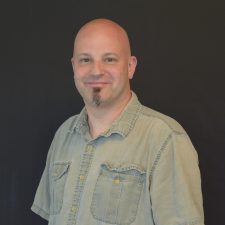Materials to Collect
- 7 Clear plastic cups
- Tissue paper or paper towels
- Water
- Food coloring (primary colors to start)
Try it!
- Start by taking the cups and putting water in the cups, (about a ¼ to half full).
- Put red food coloring in the 1st and 7th cup.
- Put yellow food coloring in the 3rd cup.
- Put blue food coloring in the 5th cup.
- Take your paper towel or tissue paper and fold in half, then in half again.
- Place one end of the paper in the first cup in the water, and the other end in the 2nd cup. the middle will make an arch shape between them.
- Place another piece of paper in the second cup, with the other end in the 3rd cup.
- Continue doing this until you reach the last cup. Every cup except the 1st and 7th cups should have two pieces of paper in them.
- Sit back and watch!
- NOTE: It will take several hours to overnight for the colors to fully mix.
What is the Science?
The water in the cups will “walk” or “climb up the paper towel due to something called capillary action. Capillary action is the movement of water within the spaces of a porous material due to the forces of adhesion, cohesion, and surface tension. What this means is that the water is filling in the little spaces between the paper fibers, working its way up the paper. this is the same method that plants use to get water from its roots all the way up to its leaves. As the water moves, it takes the food coloring with it. When the two colors meet, they mix and create a secondary color. For example, the red water in the first cup and the yellow water in the third cup mix in the second cup to make the water orange.
Ask Your Young Scientists
- What do you notice the water doing?
- Why do you think the water is moving?
- Can you predict what colors will be made in the empty cups?
More to Explore
- Try changing the order of the colors. Can you predict what colors will be made?
- Try different temperatures of water. Does hot or cold water move faster or slower?
- Try putting the cups in two rows and having more than two papers in each cup. What other colors can you make?
- https://www.steamsational.com/rainbow-walking-water-science/
If you try any of these experiments, we want to see them. Share your pictures and videos with us by using the #ScienceAtPlay and tagging @CTScienceCenter.
This content was made possible in part by the Institute of Museum and Library Services.

Andrew Fotta is a STEM educator at the Connecticut Science Center. He has currently holds a CT teaching certification for grades K-6, and has spent time in the classroom in nearly all grades, and taught middle school science. In addition to teaching classes for the Science Center, Andrew is also part of a team of educators currently creating new programs aligned with the new Next Generation Science Standards for grades PreK-9. Andrew is an avid photographer, who enjoys blending science and art in his work.



